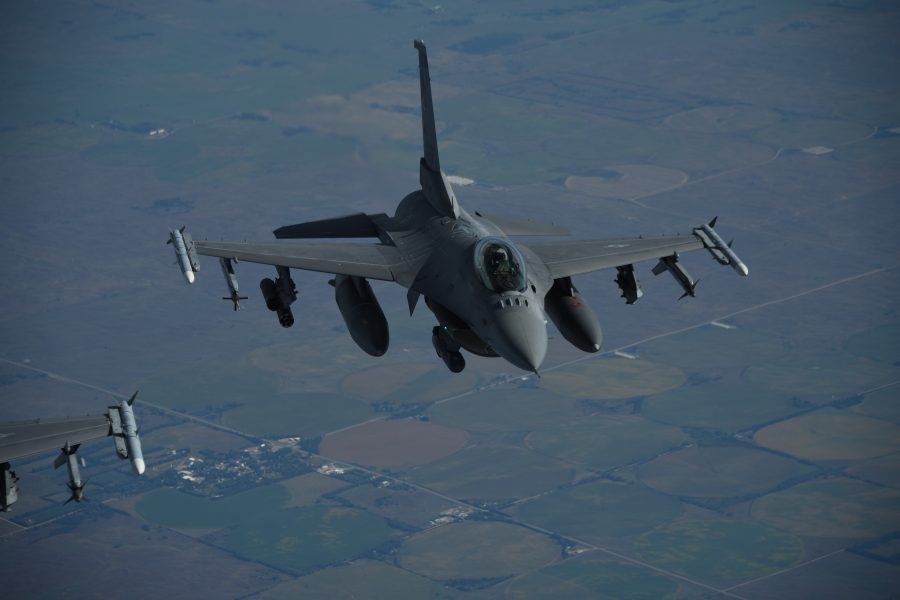Since 9/11, the No. 1 priority of the National Military Strategy (NMS) has been to “Defend the Homeland.” Some 94 percent of that mission falls to Air National Guard squadrons sitting 24/7 alert in Reagan-era F-15 and F-16 fighter aircraft.
The Air National Guard is the Air Force’s “Ace in the Hole.” Its Airmen are experienced, with more than half its pilots being former Active-Duty members who are now flying with the airlines while still serving in the Air Guard. Its units are more stable, with almost all of its people staying in the same unit for 20 years or more; 70 percent part-time members who live and work in the community, bringing with them civilian skills and values. That makes them a more cost-effective force, one that is equally trained and ready to fight and win anytime, anywhere, as the active-duty force.
This unique capability is now threatened.
The Total Air Force is now the oldest, smallest, and least ready in its 76-year history. It possesses only 2,176 fighter aircraft, less than half the 4,556 fighters USAF had in 1990. With only 48 fighter squadrons today, the Air Force is too small to successfully accomplish its NMS requirements and the needs of the nation’s six regional combatant commanders. Those requirements call for 60 fighter squadrons to fight and win.
Modernization to replace our 40-year-old fighters with new fifth-generation fighters is an absolute must given the high-threat environment posed by our adversaries, primarily China and Russia, in all domains—air, land, sea, space, and cyber. The Air National Guard’s 25 fighter squadrons, almost all flying legacy F-15, F-16, and A-10 fighters, are operating under duress. At least 12 of these squadrons are in jeopardy of losing their aircraft as the Air Force seeks to save the money needed to invest in new F-35s and F-15EXs, and eventually sixth-generation Next Generation Air Dominance (NGAD) fighters and unmanned Collaborative Combat Aircraft (CCA), which are dependent on artificial intelligence capabilities that remain not fully developed.
This “divest to invest” strategy will leave 12 or more Air Guard squadrons without the “Ace in the Hole” capabilities that have long been key to U.S. national defense. Divesting the aircraft in these squadrons before we have replacements undermines domestic security at a time when we should instead be building toward the 60-squadron requirement dictated by the NMS.
Since “Defense of the Homeland” is the No. 1 priority of the NMS, and the Air National Guard does 94 percent of the air defense mission with 16 of its 25 fighter units sitting 24/7 alert, it is imperative these units be modernized with F-35s and F-15EXs as soon as possible. These Guard squadrons need the required capabilities to defeat the potential combined threats of China and Russia and their advanced weapons, including hypersonic missiles. Every combatant commander knows that airpower, especially air superiority, is essential to dominate in today’s complex battle space.
For the past 30-plus years, the Air Force has received less funding than the Army or Navy in annual appropriations, primarily because of the priorities dictated by the War on Terrorism. Now, with China as the nation’s pacing threat, war in the Pacific looms far more likely. That calls for a change in priorities, such that the Air Force must take priority for funding. The threat of war on a global scale is as high today as virtually any time since World War II. We cannot afford to cut any of our Total Air Force fighter units at a time when we don’t even have enough fighters to meet our combatant commander requirements and successfully execute our National Military Strategy.
The United States homeland has been attacked three times since becoming a sovereign nation—in 1812 by the British, in 1941 by the Japanese, and in 2001 by al-Qaida. We must not allow another. Future attacks can and must be prevented by the critically needed modernization of our Total Air Force, and then continually keeping our military exceptionally organized, trained, equipped and totally focused on readiness to defeat any and all adversaries. Then—and only then—can we maintain the nation’s vision of “Peace through Strength.”
Retired Maj. Gen. Philip Killey was Director of the Air National Guard from 1988 to 1994, and Commander of the First Air Force from 1994-1998. A fighter pilot with over 6,500 hours, he flew 100 missions to North Vietnam with the 555th Fighter Squadron. The Killey Center for Homeland Operations, the First Air Force headquarters at Tyndall Air Force Base, Fla., is named in his honor.
